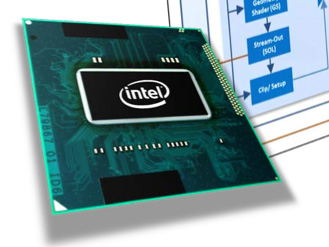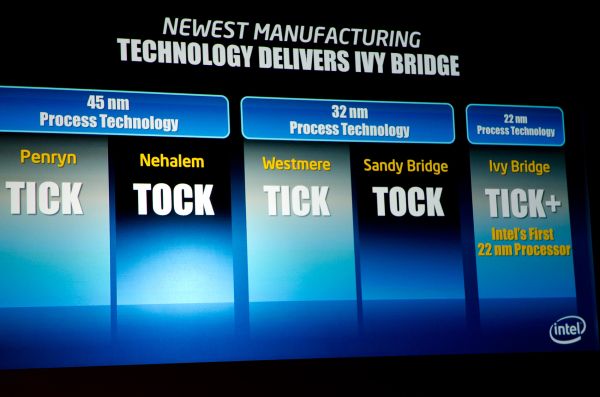The Ivy Bridge Preview: Core i7 3770K Tested
by Anand Lal Shimpi on March 6, 2012 8:16 PM EST- Posted in
- CPUs
- Intel
- Core i7
- Ivy Bridge
Note: This preview was not sanctioned or supported by Intel in any way.
I still remember hearing about Intel's tick-tock cadence and not having much faith that the company could pull it off. Granted Intel hasn't given us a new chip every 12 months on the dot, but more or less there's something new every year. Every year we either get a new architecture on an established process node (tock), or a derivative architecture on a new process node (tick). The table below summarizes what we've seen since Intel adopted the strategy:
| Intel's Tick-Tock Cadence | |||||
| Microarchitecture | Process Node | Tick or Tock | Release Year | ||
| Conroe/Merom | 65nm | Tock | 2006 | ||
| Penryn | 45nm | Tick | 2007 | ||
| Nehalem | 45nm | Tock | 2008 | ||
| Westmere | 32nm | Tick | 2010 | ||
| Sandy Bridge | 32nm | Tock | 2011 | ||
| Ivy Bridge | 22nm | Tick | 2012 | ||
| Haswell | 22nm | Tock | 2013 | ||
Last year was a big one. Sandy Bridge brought a Conroe-like increase in performance across the board thanks to a massive re-plumbing of Intel's out-of-order execution engine and other significant changes to the microarchitecture. If you remember Conroe (the first Core 2 architecture), what followed it was a relatively mild upgrade called Penryn that gave you a little bit in the way of performance and dropped power consumption at the same time.

Ivy Bridge, the tick that follows Sandy Bridge, would typically be just that: a mild upgrade that inched performance ahead while dropping power consumption. Intel's microprocessor ticks are usually very conservative on the architecture side, which limits the performance improvement. Being less risky on the architecture allows Intel to focus more on working out the kinks in its next process node, in turn delivering some amount of tangible power reduction.
Where Ivy Bridge shakes things up is on the graphics side. For years Intel has been able to ship substandard graphics in its chipsets based on the principle that only gamers needed real GPUs and Windows ran just fine on integrated graphics. Over the past decade that philosophy required adjustment. First it was HD video decode acceleration, then GPU accelerated user interfaces and, more recently, GPU computing applications. Intel eventually committed to taking GPU performance (and driver quality) seriously, setting out on a path to significantly improve its GPUs.
As Ivy is a tick in Intel's cadence, we shouldn't see much of a performance improvement. On the CPU side that's mostly true. You can expect a 5 - 15% increase in performance for the same price as a Sandy Bridge CPU today. A continued desire to be aggressive on the GPU front however puts Intel in a tough spot. Moving to a new manufacturing process, especially one as dramatically different as Intel's 22nm 3D tri-gate node isn't easy. Any additional complexity outside of the new process simply puts schedule at risk. That being said, its GPUs continue to lag significantly behind AMD and more importantly, they still aren't fast enough by customer standards.
Apple has been pushing Intel for faster graphics for years, having no issues with including discrete GPUs across its lineup or even prioritizing GPU over CPU upgrades. Intel's exclusivity agreement with Apple expired around Nehalem, meaning every design win can easily be lost if the fit isn't right.
With Haswell, Intel will finally deliver what Apple and other customers have been asking for on the GPU front. Until then Intel had to do something to move performance forward. A simple tick wouldn't cut it.

Intel calls Ivy Bridge a tick+. While CPU performance steps forward, GPU performance sees a more significant improvement - in the 20 - 50% range. The magnitude of improvement on the GPU side is more consistent with what you'd expect from a tock. The combination of a CPU tick and a GPU tock is how Intel arrives at the tick+ naming. I'm personally curious to see how this unfolds going forward. Will GPU and CPUs go through alternating tocks or will Intel try to synchronize them? Do we see innovation on one side slow down as the other increases? Does tick-tock remain on a two year cadence now that there are two fairly different architectures that need updating? These are questions I don't know that we'll see answers to until after Haswell. For now, let's focus on Ivy Bridge.










195 Comments
View All Comments
Bateluer - Tuesday, March 6, 2012 - link
Until AMD goes out of business. Then Intel gets lazy again, and the price of even a mid range CPU creeps back up above 600 dollars. You might be too young to remember the 500 dollar price tags on the first gen P3s, when Intel had no effective competition from AMD.Its not in the consumer's best interests for AMD to die off.
And, FYI, their GPUs are top notch and excellent, across the entire market. Downside is, they're basically carrying the company right now and that's not sustainable.
m.amitava - Tuesday, March 6, 2012 - link
This sans guy is hilarious!!Lets prod him a bit more and really get his fanboi juices flowing :)
AMD is the best!!!!! yaaay....Intel sucks they'll go out of business sometime next week :D
Azeraph - Thursday, March 8, 2012 - link
it doesn't really matter if the igp isn't that great most people don't buy them for their graphics power.I get the feeling that maybe intel is just putting them out there to keep it's base solid against AMD,Not that it needs it and i'm an amd fan. i found something the other day that will possibly change how tomorrows processors will use light instead of electricity.http://scitechdaily.com/penn-researchers-build-a-c...
m.amitava - Tuesday, March 6, 2012 - link
ain't he cute ? :)...I hope he's not a bot...that would break my heartGalvin - Wednesday, March 7, 2012 - link
Pleasemattgmann - Wednesday, March 7, 2012 - link
it would be cool to see a 4ghz clocked nehalem shuffled in the mix. I'm sure I'm not the only one rocking an i7 9xx wondering how much actual productivity gains are to be had with the new tech. I personally don't like to upgrade until the new gen's retail performance out-does my previous overclocked performance by a solid 15%.svata - Wednesday, March 7, 2012 - link
Is the bug with true 23.976 fps playback fixed?http://www.anandtech.com/show/4083/the-sandy-bridg...
sicofante - Wednesday, March 7, 2012 - link
I understand that will be part of the new chipsets which haven't been tested here, but I'm also very interested. As a matter of fact, I have a few HTPC customers waiting for Ivy Bridge for this sole reason.vlado08 - Friday, March 9, 2012 - link
I don't find the silence about 23.976 fps playback very promising. This is new chipset "Keep in mind that this is a preview using early drivers and an early Z77 motherboard" .... "Intel Z77 Chipset Based Motherboard"I find three possibilities:
1. They are not going to fix it with Ivy bridge.
2. They are not ready with the drivers.
3. They are ready and everything is fine but keeping silen becoause they need to sell old chips.
It didn't left much. We'll see.
Assimilator87 - Wednesday, March 7, 2012 - link
Intel's always the best, EXCEPT WHEN THEY'RE NOT! Athlon 64. Since AMD's sticking with Bulldozer's base architecture for at least a couple generations, they won't be competitive for a while, but that doesn't mean they'll never be competitive.